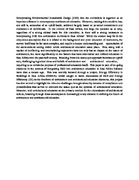| dc.contributor.author | Olweny, Mark R. O. | |
| dc.date.accessioned | 2017-02-25T14:06:55Z | |
| dc.date.available | 2017-02-25T14:06:55Z | |
| dc.date.issued | 2016 | |
| dc.identifier.citation | Olweny, M. R. O. (2016). That is too radical for us: Sustainable design education in East Africa. in LaRoche, P. &Schiler, M. (eds.) PLEA 2016 - Cities, Buildings, People: Towards Regenerative Environments, Proceedings of the 32nd International Conference on Passive and Low Energy Architecture, 11-13 July, Los Angeles, USA, pp1832-1838 | en_US |
| dc.identifier.uri | http://hdl.handle.net/20.500.12280/430 | |
| dc.description.abstract | Incorporating Environmental Sustainable Design (ESD) into the curriculum is regarded as an important element in contemporary architectural education. However, making this transition has, and still is, somewhat of an uphill battle, achieved largely based on personal commitment and endeavours of individuals. In the context of East Africa, this begs the question as to why, regardless of a strong ethical basis for this transition, is there still a strong resistance to incorporating EDS into architecture curricula in East Africa? While the answer may lie in the ubiquitous assumption that is it related to the background and prior education of instructors, the answer itself may be far more complex, and require a deeper understanding and appreciation of the socio-cultural setting within which architectural education takes place. This, along with a myriad of conflicting and contradicting trajectories have not only had an impact on the nature of architecture, but more significantly on the factors that have determined and defined education in East Africa over the past half century. Breaking from this status quo approach becomes an uphill task, challenging ingrained ideas and beliefs of architecture and architectural education, requiring us to revisit the purpose of professional education itself. This paper is part of on-going discourse in the process of integrating ESD into architecture education in East Africa initiated more than a decade ago. This was recently boosted through a project, Energy Efficiency in Buildings in East Africa (EEBEA), which sought to move discussions of ESD and Energy Efficiency (EE) to the forefront of architecture and architectural education discourse, this project has also served to highlight the inherent challenges brought about by decades of compliance and protectionism that served to entrench the status quo as the epitome of architectural education. However, with architectural education as the primary conduit for the transmission of architectural culture, breaking through these stereotypes is increasingly a key element in defining the future of architecture and architectural education. | en_US |
| dc.language.iso | en | en_US |
| dc.publisher | PLEA | en_US |
| dc.subject | Sustainable design education in East Africa | en_US |
| dc.title | That is too radical for us: | en_US |
| dc.title.alternative | Sustainable design education in East Africa. | en_US |
| dc.type | Article | en_US |


